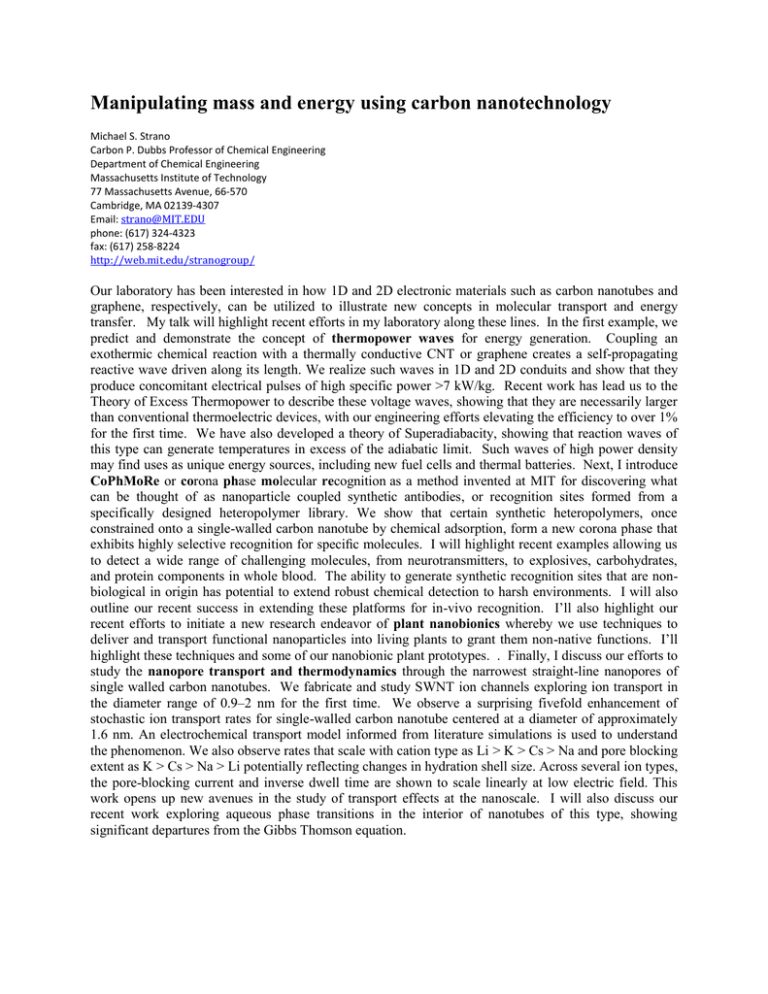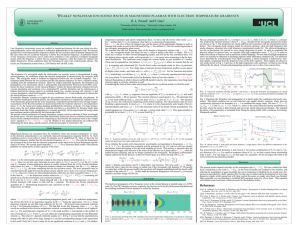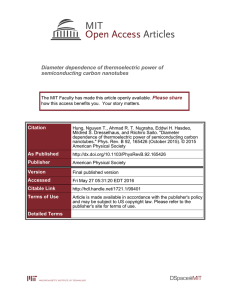Manipulating mass and energy using carbon nanotechnology
advertisement

Manipulating mass and energy using carbon nanotechnology Michael S. Strano Carbon P. Dubbs Professor of Chemical Engineering Department of Chemical Engineering Massachusetts Institute of Technology 77 Massachusetts Avenue, 66-570 Cambridge, MA 02139-4307 Email: strano@MIT.EDU phone: (617) 324-4323 fax: (617) 258-8224 http://web.mit.edu/stranogroup/ Our laboratory has been interested in how 1D and 2D electronic materials such as carbon nanotubes and graphene, respectively, can be utilized to illustrate new concepts in molecular transport and energy transfer. My talk will highlight recent efforts in my laboratory along these lines. In the first example, we predict and demonstrate the concept of thermopower waves for energy generation. Coupling an exothermic chemical reaction with a thermally conductive CNT or graphene creates a self-propagating reactive wave driven along its length. We realize such waves in 1D and 2D conduits and show that they produce concomitant electrical pulses of high specific power >7 kW/kg. Recent work has lead us to the Theory of Excess Thermopower to describe these voltage waves, showing that they are necessarily larger than conventional thermoelectric devices, with our engineering efforts elevating the efficiency to over 1% for the first time. We have also developed a theory of Superadiabacity, showing that reaction waves of this type can generate temperatures in excess of the adiabatic limit. Such waves of high power density may find uses as unique energy sources, including new fuel cells and thermal batteries. Next, I introduce CoPhMoRe or corona phase molecular recognition as a method invented at MIT for discovering what can be thought of as nanoparticle coupled synthetic antibodies, or recognition sites formed from a specifically designed heteropolymer library. We show that certain synthetic heteropolymers, once constrained onto a single-walled carbon nanotube by chemical adsorption, form a new corona phase that exhibits highly selective recognition for specific molecules. I will highlight recent examples allowing us to detect a wide range of challenging molecules, from neurotransmitters, to explosives, carbohydrates, and protein components in whole blood. The ability to generate synthetic recognition sites that are nonbiological in origin has potential to extend robust chemical detection to harsh environments. I will also outline our recent success in extending these platforms for in-vivo recognition. I’ll also highlight our recent efforts to initiate a new research endeavor of plant nanobionics whereby we use techniques to deliver and transport functional nanoparticles into living plants to grant them non-native functions. I’ll highlight these techniques and some of our nanobionic plant prototypes. . Finally, I discuss our efforts to study the nanopore transport and thermodynamics through the narrowest straight-line nanopores of single walled carbon nanotubes. We fabricate and study SWNT ion channels exploring ion transport in the diameter range of 0.9–2 nm for the first time. We observe a surprising fivefold enhancement of stochastic ion transport rates for single-walled carbon nanotube centered at a diameter of approximately 1.6 nm. An electrochemical transport model informed from literature simulations is used to understand the phenomenon. We also observe rates that scale with cation type as Li > K > Cs > Na and pore blocking extent as K > Cs > Na > Li potentially reflecting changes in hydration shell size. Across several ion types, the pore-blocking current and inverse dwell time are shown to scale linearly at low electric field. This work opens up new avenues in the study of transport effects at the nanoscale. I will also discuss our recent work exploring aqueous phase transitions in the interior of nanotubes of this type, showing significant departures from the Gibbs Thomson equation.






